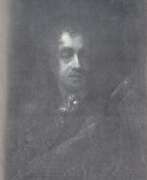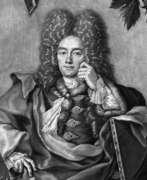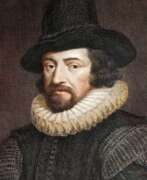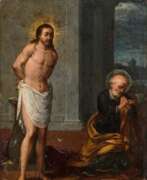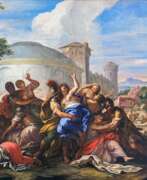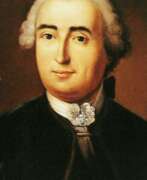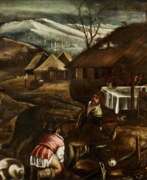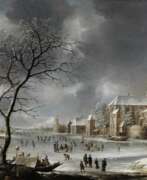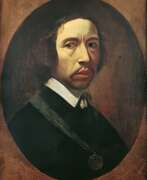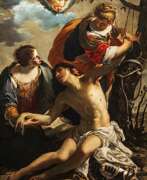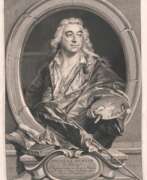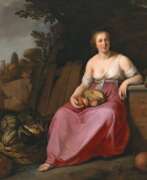17th century
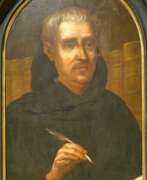

Abraham a Sancta Clara, real name Johann Ulrich Megerle, was an Augustinian monk and satirist, court preacher in Vienna.
Possessing an inimitable style of preaching that included folksy humor and harsh acrimony, Abraham was very popular with his contemporaries. He fearlessly scourged human vices, using both high pathos and puns, while conveying religious and moral messages. Some 600 of his recorded sermons on various subjects have survived.


Guido Ubaldo Abbatini was an Italian Baroque painter, celebrated for his fresco works and significant contributions during the artistic fervor of 17th-century Rome. Born around 1600 in Città di Castello, Umbria, and later active in Rome and Usigni, Abbatini's career was marked by his apprenticeships under prominent artists such as Giuseppe Cesari and Pietro da Cortona. He is also noted for his association with Gian Lorenzo Bernini, under whom he worked on notable projects like the frescoes in the Cornaro Chapel.
Abbatini's works are characterized by their dynamic compositions and vibrant use of color, which were typical of the Baroque movement's dramatic style. His artistic contributions extend to several churches in Rome, where his frescoes continue to be admired for their artistic and historical significance.
For art collectors and enthusiasts interested in Baroque art, Guido Ubaldo Abbatini's works represent a pivotal chapter in Italian art history. His paintings not only reflect the rich cultural heritage of the era but also showcase the evolution of Baroque artistic expressions in Italy.
To stay updated on exhibitions and sales related to Guido Ubaldo Abbatini's works, consider subscribing to updates. This service will keep you informed about new discoveries and auction events, enhancing your collection and appreciation of Baroque art.


Filippo Abbiati was an Italian painter, renowned for his contribution to the Baroque period. Born in Milan in 1640, Abbiati's training under Carlo Francesco Nuvolone and Antonio Busca honed his skills, leading him to develop a distinct style characterized by fluid touch and luminous foundations. His work was heavily influenced by early seventeenth-century Lombard painting and later, the Roman Baroque and Venetian painting.
Abbiati's career was predominantly based in Milan, where he produced numerous significant religious and historical paintings. Notable works include the altarpiece of the Preaching of St. John the Baptist for the Sanctuary of the Beata Vergine dei Miracoli in Saronno and the extensive frescoes in the Milanese church of Sant'Alessandro. His masterpieces are celebrated for their dynamic composition and expressive intensity, marking a transition toward the Rococo movement.
Though details about his later years remain sparse, Abbiati's legacy lives on through his influential frescoes and the mentorship of notable students like Alessandro Magnasco. His works can still be admired in places like the Pinacoteca di Brera in Milan and the Biblioteca Ambrosiana.
For collectors and enthusiasts looking to explore the depth of Italian Baroque, Filippo Abbiati's work offers a rich narrative woven through the tapestry of art history. Sign up for updates on auctions and new discoveries related to Filippo Abbiati, ensuring you stay informed about opportunities to own a piece of this illustrious artist's legacy.
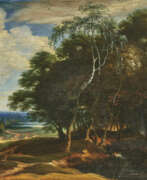

Lucas Achtschellinck was a Flemish landscape painter. He is counted among the landscape painters active in Brussels referred to as the School of Painters of the Sonian Forest who all shared an interest in depicting scenes set in the Sonian Forest, which is located near Brussels.


Francesco Albani was a renowned Italian painter and fresco artist. He is celebrated for his contributions to the academic Bolognese school, which was profoundly influenced by the Carracci family, under whom Albani trained. Albani's artistic journey began at the young age of 12, marking the start of a career that would see him become one of the 17th-century's most esteemed Bolognese masters.
Francesco Albani's style is characterized by its lyricism and often features cherubic figures, a trait that became his signature. Despite not embracing the monumentality or tenebrism prevalent in the works of his contemporaries, his thematic appeal and mannerist elegance have earned him a place in art history. His works often comprise mythological and religious scenes, executed with a refined and lyrical view of nature. This approach helped disseminate the classical ideals prominent in Carracci's landscapes.
Among Francesco Albani's notable works are his frescoes in the Hall of Aeneas at Palazzo Fava in Bologna and Palazzo Doria Pamphilj in Rome, and his paintings "The Judgment of Paris" and "The Toilet of Venus". His works can be found in prestigious collections worldwide, including the Museo del Prado, Galleria Borghese in Rome, and the Hermitage in St. Petersburg.
Francesco Albani's influence extended beyond his lifetime, with his classicising and idealised scenes finding favor with 18th-century French painters and collectors. However, his popularity waned during the 19th century. Despite this, his work remains an integral part of the study of Baroque art, particularly in understanding the transition from Mannerism to Baroque styles.
For collectors and experts in art and antiques, the legacy of Francesco Albani presents an opportunity to explore a pivotal moment in the history of Italian painting. His works not only provide aesthetic pleasure but also serve as important cultural artifacts, offering insights into the artistic trends and societal values of the 17th century.
If you are passionate about art history and wish to stay informed about new discoveries, sales, and auction events related to Francesco Albani, consider signing up for updates. This subscription will ensure you remain at the forefront of developments in the world of art and antiques, especially concerning this remarkable Italian master.


Cherubino Alberti, also called Borghegiano, was an Italian engraver and painter. He is most often remembered for the Roman frescoes completed with his brother Giovanni Alberti during the papacy of Clement VIII. He was most prolific as an engraver of copper plates.


Tommaso Aldrovandini was an Italian painter of the Baroque period. He mainly painted perspective views and architectural subjects (quadratura), in which the figures were painted by Marcantonio Franceschini and Carlo Cignani. He decorated churches, palaces, and theaters in Forlì, Verona, Venice, Parma, Turin, Ferrara, and Genoa, and especially in his native Bologna. Among his pupils was Giovanni Benedetto Paolazzi.




Francesco Allegrini da Gubbio was an Italian painter of the Baroque period.
He was admired as a battle painter. He was active in Rome, Genoa, Savona, and Naples. In Rome, he painted in the Vatican Loggias. He also painted in the church of San Marco, Rome, and the chapel of San Antonio in the church of Santi Cosma e Damiano. He painted for the Casa Durazzo in Genoa. In Savona he painted for the Palazzo Gavotti and the Savona Cathedral.


Cristofano Allori was an Italian painter of the late Florentine Mannerist school, painting mostly portraits and religious subjects. Allori received his first lessons in painting from his father, Alessandro Allori, but becoming dissatisfied with the hard anatomical drawing and cold coloring of the latter, he entered the studio of Gregorio Pagani. When still young he became a court portraitist for the Medicis, though many of his commissions were replicas of portraits by his predecessor Bronzino, or had participation by others.[citation needed. His pictures are distinguished by their close adherence to nature and the delicacy and technical perfection of their execution. His most famous work, in his own day and now, is Judith with the Head of Holofernes.


Alessandro Allori, full name Alessandro di Cristofano di Lorenzo del Bronzino Allori, was an Italian painter of the Florentine school of late Mannerism.
Allori was one of the major artists of Florence in the late 16th century. He painted prostrate images and portraits. His son Cristofano Allori (1577-1621) also became an artist.
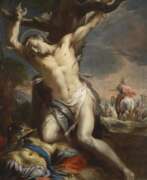

Martino Altomonte, born Johann Martin Hohenberg, was an Italian Baroque painter renowned for his artistic endeavors across Poland and Austria. With his roots in a family of artists, Altomonte honed his craft under the tutelage of Giovanni Battista Gaulli and Carlo Maratta in Rome, before making a significant name change and cultural shift to become a court painter in Poland under King John III Sobieski.
Martino Altomonte's oeuvre is marked by a vibrant blend of Neapolitan chiaroscuro and Venetian color, elements that distinguished his style from his contemporaries. This unique combination is particularly evident in his altarpieces and frescoes, which include major works like the ceiling frescoes in Vienna's Lower Belvedere and the high altarpiece at the Stiftskirche Wilhering. Despite the loss of many of his altarpieces, some key pieces survive, offering a glimpse into his dramatic yet harmonious approach.
Throughout his career, Martino Altomonte was deeply involved in the Viennese art scene, his works contributing significantly to the development of Baroque painting in the region. His legacy is continued by his son, Bartolomeo Altomonte, who also became a noted painter. Martino Altomonte's impact on Baroque painting, with his mastery of light and shadow, makes his work a continued point of study and appreciation among art collectors and historians.
For those interested in exploring the works and life of Martino Altomonte further, consider subscribing for updates on new product sales and auction events featuring this illustrious artist. Stay connected to the world of art and ensure you never miss an opportunity to own a piece of Baroque brilliance.


Antonio Amorosi was an Italian painter of the late Baroque period.
Amorosi studied in Rome in the studio of Giuseppe Ghezzi. He produced portraits and religious works, but he is best known for his genre paintings of bambocanti. The artist has a keen eye for the everyday lives of ordinary people, particularly children, whose world he depicts in a gentle and delicate manner. Among Amorosi's most characteristic and best works are "Boy with a Glass" and "Boy with a Dog", preserved in the Pinacoteca Comunale in Deruta.


Giovanni Andrea Ansaldo was an Italian painter active mainly in Genoa. He trained under Orazio Cambiasi and possibly collaborated with Bernardo Strozzi. Ansaldo's works are typical of the Genoese eclecticism of the early 17th century, influenced by Flemish artists. Ansaldo was responsible for the fresco decoration of the cupola of the Basilica della Santissima Annunziata del Vastato of Genova. His Annunciation fresco is considered the first true Baroque painting in the city.


Pietro Aquila was an Italian painter and printmaker of the Baroque period. He was born in Palermo. He mentored his nephew, the printmaker Francesco Faraone Aquila. He trained at the school of Palermo painter and engraver Pietro del Po and worked, like a teacher, first at home, in Palermo, then in Naples and Rome, where he pursued the ecclesiastical career. For his paintings that he left in Palermo in the church of the Pietà (Parabola del Figlio Prodigo, Abraham and Melchizede) and in the cloister of S. Maria delle Vergini (S. Benedetto), as well as some frescoes in the Chapel of the Rosary in S. Cita, he gained the status of "respectable painter", loyal to the Raphaelesque tradition. But Aquila established himself first and foremost as a copper engraver, dedicating himself to the distribution and popularization of many of the most remarkable paintings with the help of which the sacred and profane buildings of Rome were adorned at that time. He made engravings after the works of different artists that were dear to him including: Raphael before any other, and then Annibale Carracci, Pietro da Cortona, Giovanni Lanfranco, Lazzaro Baldi, Ciro Ferri, Morandi, Franceschini, and finally Carlo Maratta, who was bound to him by a close friendship.


Francesco Faraone Aquila was an Italian engraver. In 1690 he moved to Rome where his brother Pietro had been an engraver for several decades in major workshops in the capital. Pope Clement XI gave him an order which has remained his main work - engraving the bas-reliefs of the Antoninus Pius column and its pedestal. Another important work by Francesco Aquila is the engraving of the frescoes of the dome of the Cathedral of Parma by Correggio and the painting of the Vatican chambers. Following the antique taste established in the 18th century, Aquila engraved various Roman classical works: statues, vases and triumphal arches, thus satisfying the demand of mainly foreign visitors, mainly German and English. His portraits of his contemporaries, both painters and clergymen, also enjoyed great popularity.


Giacomo Antonio Arland was an Italian Baroque painter. At the age of 20 he travelled to Paris, where he was patronised by the Duke of Orleans. He became famous as a portrait miniaturist. In 1729 Giacomo Antonio Arland returned to Genoa as a wealthy man.
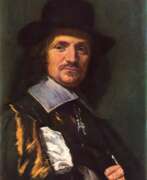

Jan Asselijn, known by his nickname Little Crab (Crabbetje, Krabbetje), was a French and Dutch painter of the Golden Age of Dutch painting.
As a child, Asselijn moved with his family from France to Amsterdam, studied and lived in Italy, where he became a member of the artists' society "Migratory Birds". And he received the nickname Crabbetje because of his physical features - small stature and a damaged arm.
Asselijn painted mainly scenes of horses, cavalry attacks and battles. His works also include genre works, landscapes and animals. Asselijn's most famous painting in this genre is The Frightened Swan, although it is also attributed allegorical meaning.


Gioacchino Assereto was a prominent Italian Baroque painter, celebrated for his dramatic and emotionally charged works that often depicted religious and historical subjects. Born in Genoa in 1600, Assereto's early career was marked by his apprenticeship with Luciano Borzone and Giovanni Andrea Ansaldo, which laid the foundation for his development as an artist. His paintings are known for their vibrant light effects and dynamic compositions, a style significantly influenced by Caravaggio during Assereto's brief visit to Rome in 1639. This influence is evident in his masterful use of chiaroscuro and sfumato techniques, which added depth and realism to his works.
Assereto's oeuvre includes powerful pieces like "The Lamentation," notable for its intense shadows and dramatic portrayal of Christ's body, and "The Torture of Prometheus," a work that showcases his later years' shift towards more emotional and theatrical compositions. His "Death of Cato" and "Ecce Homo" further illustrate this evolution, moving from refined styles to bold, expressive techniques that emphasize violent emotions through the dramatic effects of light.
Throughout his career, Assereto's works were highly regarded, with contemporary Genoese biographer Raffaele Soprani praising him as incomparable. His paintings can be found in significant collections, including the Musei di Strada Nuova in Genoa, the Cummer Museum of Art and Gardens, and the National Gallery in London. Assereto's legacy extends beyond his lifetime, with his son Giuseppe Assereto and others producing many copies of his work, ensuring the endurance of his artistic influence.
For art collectors and experts, Assereto's work embodies the Baroque spirit with its emotional intensity and technical mastery. His ability to convey deep psychological tension and his innovative use of lighting make his paintings a valuable study in the evolution of Baroque art.
If you're passionate about Baroque painting and interested in staying updated on sales and auction events related to Gioacchino Assereto's works, consider signing up for updates. This subscription will ensure you're informed about new opportunities to acquire pieces by this master of the Baroque period, enriching your collection with the depth and drama of Assereto's art.


Hendrick Avercamp was a seminal Dutch painter during the Dutch Golden Age. He is celebrated as one of the earliest landscape painters of the 17th-century Dutch school, specializing in vibrant winter scenes of the Netherlands. His paintings are filled with colorful and lively depictions of people engaging in various activities against the backdrop of the Dutch winter landscape.
Educated by the Danish-born portrait painter Pieter Isaacsz, Hendrick Avercamp's work reflects a strong influence from the Flemish painting tradition, especially evident in the landscapes reminiscent of Pieter Bruegel the Elder. His technique of aerial perspective, where objects in the foreground are painted with richer colors than those in the distance, creates a remarkable impression of depth in his paintings.
Hendrick Avercamp's most ambitious and acclaimed work, 'Winter Landscape with Ice Skaters', painted around 1608, is a detailed panorama of human and animal activities during a harsh winter. This painting, along with others like 'Winter Landscape with a Frozen River and Figures' and 'Winter Landscape with Skates and People Playing Golf', showcase his knack for narrative, capturing various facets of 17th-century Dutch society enjoying the winter season.
Despite being mute and probably deaf, Hendrick Avercamp's keen observation skills are evident in his works, where he intricately portrays diverse classes engaging in various winter activities. He produced about a hundred paintings, many of which can be seen in the Rijksmuseum in Amsterdam and the Mauritshuis in The Hague. His work was also celebrated for its historical quality, providing a glimpse into the life of different societal levels in the Netherlands at that time.
For collectors and enthusiasts of art and antiques, Hendrick Avercamp's paintings offer a fascinating window into the Dutch Golden Age, with their vivid portrayal of life and activities in a winter setting. His works, characterized by meticulous detail and a cheerful narrative, remain an integral part of the conversation in the history of Dutch art.
To stay updated on the latest insights and collections related to Hendrick Avercamp's works, consider subscribing to our updates. Stay informed about new sales, exhibitions, and auction events featuring this master of Dutch winter landscapes.


Barent Avercamp was a Dutch painter. He was taught by his uncle Hendrick Avercamp, who was also a painter. Barent primarily painted scenes depicting Netherlands in winter. He was a member of the Guild of Saint Luke, and traveled around the Netherlands including Zwolle and Zutphen for his settings and inspiration.


Jacob Adriaensz Backer was a prolific artist of the Dutch Golden Age, known for his dynamic portraits, religious subjects, and mythological scenes. Over a span of twenty years, Backer produced approximately 140 paintings, standing out for his quick execution and attention to detail. His ability to capture intricate details like cuffs, fur, and collars within a short period was renowned, exemplifying the Dutch wet-on-wet painting technique's success during his era.
Influenced by notable figures such as Wybrand de Geest, Peter Paul Rubens, and Abraham Bloemaert, Backer was also celebrated for his drawings of nudes, showcasing his versatile skill set. His works were a testament to the baroque movement, characterized by vivid expression and intricate detail. Notable among his works are portraits that convey the subject's essence with exceptional clarity and depth, earning him a distinguished place among his contemporaries in Amsterdam.
Despite his significant contributions to Dutch art, Backer led a life focused solely on his art, never marrying or purchasing a home, possibly sharing his living quarters with relatives. He was deeply embedded in the artistic milieu of Amsterdam, having been one of the most independent pupils of Rembrandt between 1632 and 1634, absorbing and reflecting the master's style in his works.
For collectors and experts in art and antiques, Jacob Adriaensz Backer's work offers an insight into the Dutch Golden Age's rich cultural and artistic landscape. His legacy continues to be celebrated in major museums and collections worldwide, including the Rijksmuseum in Amsterdam and the National Museum in Warsaw, where his influence on portrait and genre painting remains undisputed.
To stay updated on exhibitions, sales, and auctions related to Jacob Adriaensz Backer, subscribing to newsletters from reputable art galleries and auction houses is advisable. This ensures you receive timely information on opportunities to engage with the works of this masterful Dutch Golden Age painter.


Giuseppe Badaracco also called “Il Sordo” (the Deaf), was an Italian painter of the Baroque period, active mainly in Genoa, in Liguria and in the island of Corsica. He worked for some years in Florence, where he copied many of the works of Andrea del Sarto. Returning to Genoa, he painted mainly for private customers. He worked also in Corsica (at that time part of the Republic of Genoa), where he painted locally influential paintings for some churches around Bastia.


Elias Baeck called "Heldenmuth", was a German painter and engraver from Augsburg. Baeck worked for some time in Rome, then in Laybach, but finally returned to Augsburg, where he died in 1747. His chief works — both in painting and engraving — were portraits and landscapes. His engravings are sometimes signed "E.B.a.H.", standing for "Elias Baeck, alias Heldenmuth".


Ludolf Bakhuizen was a Dutch painter of the 17th and early 18th centuries. He is known as an outstanding master of seascapes. Bakhuizen also painted biblical themes and portraits of his contemporaries as well as engravings and miniature models of ships.
Ludolf Bakhuizen is considered one of the best marine painters of the Golden Age of Dutch painting. Among the admirers of his work were many influential European rulers, including the Russian Tsar Peter the Great. The master met Peter I, who visited Amsterdam in the mid-1690s and, according to contemporaries, even managed to give some painting lessons to the Russian tsar. In addition, Вakhuizen made models of all kinds of ship designs on commission from Peter the Great.
Toward the end of his life, the Amsterdam authorities honored Bakhuizen by opening his own gallery on the top floor of the City Hall for his achievements in the fine arts. The best masterpieces of his work are now preserved in museums in the Netherlands, Germany, England, France, and Italy.


John Bale was an English churchman, historian and controversialist, and Bishop of Ossory in Ireland. He wrote the oldest known historical verse drama in English (on the subject of King John), and developed and published a very extensive list of the works of British authors down to his own time, just as the monastic libraries were being dispersed. His unhappy disposition and habit of quarrelling earned him the nickname "bilious Bale".


Antonio Balestra, an Italian painter, is celebrated for his contributions to the Baroque art movement. Initially training in his hometown, Balestra's artistic journey took him to Venice and Rome, where he honed his skills and absorbed diverse artistic influences. By 1694, his talents were recognized with a prestigious award from the Accademia di San Luca in Rome, underscoring his growing reputation.
Antonio Balestra's works, characterized by their adherence to classical artistic standards, are found in various Italian cities, including Venice, Bologna, and Verona. He was known for his religious paintings, such as "The Miracle of Saint Nicholas" and "The Annunciation," as well as his contributions to church decorations and altarpieces.
Despite his traditional approach, Antonio Balestra's legacy is cemented in the art world, with works displayed in notable museums and his influence extending to pupils and subsequent generations of artists. His devotion to the established norms of academic painting reflected a broader dialogue within the art community about innovation versus tradition during his time.
For art collectors and enthusiasts, Antonio Balestra's works offer a glimpse into the Baroque era's rich artistic heritage, showcasing a blend of devout religiosity and meticulous craftsmanship. To stay informed about Antonio Balestra's art and related auction events, consider subscribing to updates, ensuring you remain connected to the enduring appeal of his artistic legacy.


Simone Barabino was an Italian painter of the late-Mannerist style. Born in Val de Polcevera, near Genoa, he was mainly active in his native city, where he trained with Bernardo Castello. Notable works include San Diego restoring sight to blind child for the Nunziata del Guastato in Genoa and Dead Christ with the Virgin and Saints Michael and Andrew for the church of San Girolamo at Milan.


Giovanni Francesco Barbieri, better known as Guercino, was an Italian Baroque painter and draftsman from Cento in the Emilia region, who was active in Rome and Bologna. The vigorous naturalism of his early manner contrasts with the classical equilibrium of his later works. His many drawings are noted for their luminosity and lively style.


Federico Barocci, an Italian Renaissance painter and printmaker, was celebrated for his vibrant use of color and dynamic compositions. Born around 1533 in Urbino, Italy, a hub of Renaissance culture, Barocci's early life was steeped in the rich artistic heritage of the time. His training included an apprenticeship with his father, a sculptor, and later with notable artists such as Battista Franco Veneziano and Taddeo Zuccari.
Federico Barocci's work, known for its emotional intensity and use of light, positioned him as a critical link between the Mannerist style of the 16th century and the emerging Baroque period. His paintings often depicted religious scenes, imbued with a warmth and spirituality that resonated with viewers. His unique approach to color and composition had a significant influence on later artists, including the Baroque masters Peter Paul Rubens and Gian Lorenzo Bernini.
Despite suffering from chronic illness, possibly due to poisoning, Federico Barocci's output remained prolific and influential. His works can be found in several prestigious galleries, including the Uffizi in Florence, where his "Madonna del Popolo" and "Martyrdom of Saint Vitale" are displayed. These pieces, along with others like "The Deposition" in the Cathedral of Perugia and "Noli me Tangere" in Munich, showcase his mastery in portraying human emotion and divine radiance.
Collectors and experts in art and antiques will appreciate the depth and innovation of Federico Barocci's work. His legacy as a master colorist and draughtsman is undeniable, making his pieces a valuable addition to any collection.
To stay updated on sales and auction events related to Federico Barocci, sign up for our exclusive updates. This subscription ensures you're the first to know about new opportunities to acquire works connected to this remarkable artist.


Robert Barrow was an American Quaker missionary, traveler, and writer.
Barrow participated in a voyage led by a Quaker trader from Jamaica, Jonathan Dickinson (1663-1722), traveling from Kingston to Philadelphia, but ran aground on the east coast of Florida. They were captured several times by the natives of the region. In March 1696, Jonathan Dickinson and his family and Robert Barrow sailed from Charles Town and reached Philadelphia fourteen days later. On April 4, 1697, three days after arriving in Philadelphia, Robert Barrow died.
Dickinson's account of their capture, release, and subsequent rescue by the Spanish was published in 1699 in Philadelphia under the title God's Patronizing Providence. The book became a bestseller. Robert Barrow had time to write his account of the adventure after their rescue by the Spanish governor of St. Augustine, who provided them with a canoe to take them to the English settlements in South Carolina.
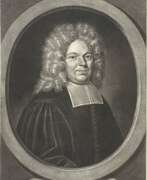

Jacques Basnage de Beauval was a French theologian and historian, diplomat and writer.
His father was a prominent lawyer and his grandfather and great-grandfather were pastors, Jacques studied theology and languages at the Academy of Saumur, then at Geneva and Sedan. In 1676, Jacques Basnage was appointed pastor at Rouen during the revocation of the Edict of Nantes, was forced to flee France for Holland, where he worked as a theologian, polemicist, historian, and diplomat in the service of the Grand Pensioner Hensius.
In 1717, on behalf of Holland, Basnage was sent to sign the treaty of the Triple Alliance (France, Holland, England). In the Annals of the United Provinces (1719-1726), compiled from the peace negotiations held at Münster, he displays breadth of vision, wisdom, and impartiality.
About 1719 Jacques Basnage was appointed historiographer of the Dutch states. He wrote several books on the Bible, the history of the Church, and the history of the Jewish people. Among the best known of these are his History of the Religion of the Protestant Denominations (1690), History of the Church of Jesus Christ to the Present Time (1699), written from Protestant positions, and History of the Jews (1706), as well as Jewish Antiquities, or Critical Notes on the Republic of the Jews (1713).
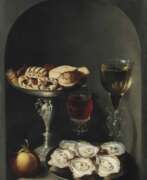

Osias Beert the Elder, a Flemish painter born around 1580 and active until his death in 1623, was a key figure in the development of still life painting in Northern Europe. His work, primarily focused on flower and banquet (or "breakfast") pieces, showcased a pioneering approach to these genres, setting a precedent for future artists.
Beert's technique involved painting on oak panels and copper, employing a glazing method that layered very fluid oil paints to achieve transparency and a rich color palette. This method allowed him to create still lifes that were not only visually appealing but also rich in detail and depth. He was known for his intricate compositions that often featured a high viewpoint and compact arrangements, providing a better sense of spatial coherence in his later works.
Despite the significant impact of his work, only a few signed pieces by Beert are known, making the attribution of his works challenging. His influence extended to his pupils and his nephew Frans Ykens, as well as other Antwerp artists such as Jacob Foppens van Es and Jacob van Hulsdonck, indicating his pivotal role in the early still life painting tradition in Flanders.
For collectors and experts in art and antiques, Osias Beert the Elder's contributions to the evolution of still life painting represent an essential chapter in the history of art. His ability to depict the transient beauty of flowers and the lavish detail of banquet scenes continues to captivate audiences and serves as a testament to his skill and creativity.
To delve deeper into the fascinating work of Osias Beert the Elder and to stay informed about new discoveries or auction events related to his oeuvre, consider signing up for updates tailored to enthusiasts of art history and antique collections. This subscription will ensure you are well-informed about the latest developments and opportunities related to this influential artist's work.


Abraham Janszoon Bega, also Abraham Janszoon Begeyn, was a Dutch landscape painter, still life painter, draftsman and decorator.
Abraham's giftedness was appreciated very early and already at the age of 17 he became a member of the professional Guild of St. Luke of Leiden, studied with Harlem painter Nicholas Berchem (1620-1683), traveled extensively in Europe and painted.
Abraham Bega painted many landscapes, including coastal river views, architectural views, with flocks and shepherds. He also painted floral compositions and still lifes with hunting paraphernalia. In 1688 he was invited to Berlin as court painter to Elector Frederick III, but he worked there mainly as an interior decorator and castle painter.


Giovanni Battista Beinaschi, an Italian painter and fresco artist of the Baroque era, was born in 1636 and left an indelible mark on the art world before his death in 1688. Renowned for his dynamic compositions and vibrant use of color, Beinaschi's work epitomizes the grandeur and emotive power of Baroque art, reflecting the period's cultural and artistic aspirations.
Beinaschi's contributions to art are notable for their intricate details, dramatic use of light and shadow, and the emotional intensity of the figures portrayed. His mastery in fresco and oil painting allowed him to create expansive religious narratives and intimate portraits alike, each brimming with life and depth.
Among his celebrated works, those housed in esteemed museums and galleries across Europe serve as testaments to his skill and creativity. Beinaschi's frescoes, in particular, are admired for their architectural harmony and the seamless integration of figures into their surroundings, showcasing his innovative approach to spatial composition.
For collectors and experts in art and antiques, Giovanni Battista Beinaschi's paintings are more than just visual delights; they are windows into the soul of the Baroque period. His ability to convey complex emotions and spiritual themes through art makes his works highly sought after and revered in the history of painting.
If you wish to delve deeper into the world of Baroque art and explore the genius of Giovanni Battista Beinaschi, consider signing up for updates. This subscription will keep you informed about new discoveries, sales, and auction events related to Beinaschi's works, ensuring you never miss an opportunity to appreciate or acquire pieces by this exceptional artist.


Jacques Bellange was an artist and printmaker from the Duchy of Lorraine (then independent but now part of France) whose etchings and some drawings are his only securely identified works today. They are among the most striking Northern Mannerist old master prints, mostly on Catholic religious subjects, and with a highly individual style. He worked for fourteen years in the capital, Nancy as court painter to two Dukes of Lorraine, before dying at the age of about forty, and almost all his prints were produced in the three or four years before his death. None of his paintings are known to have survived, but the prints have been known to collectors since shortly after his death, though they were out of critical favour for most of this period. In the 20th century they have been much more highly regarded, although Bellange is still not a well-known figure.


Jacob Adriaensz. Bellevois was a Dutch marine painter.
Bellevois was a follower of Jan Porcellis and Simon de Vlieger and specialized in seascapes. The artist was apparently well acquainted with maritime affairs: his dramatic depictions of various ships in a raging sea and shipwrecks on cliffs are full of characteristic detail.


Antonio Bellucci was an Italian painter and decorator, celebrated for his contributions to the Rococo movement, blending classical elements with a distinctive Rococo flair. Born in Pieve di Soligo in 1654, he initially trained with Domenico Difnico in Venetian Dalmatia, modern-day Croatia, before establishing himself in Venice and across Europe. Bellucci's works are known for their baroque joyfulness, pictorial finesse, and a palette of soft, nuanced colors, making him a key precursor to artists like Tiepolo. His paintings are characterized by their soft, virtuoso brushwork, often incorporating chiaroscuro effects learned from the Tenebrism movement, with clearly contoured figures reminiscent of Veronese, especially in the portrayal of women.
Throughout his career, Antonio Bellucci's international presence grew, especially in German-speaking regions, due to his extensive work abroad. He spent significant periods in Vienna, painting allegorical ceilings for Palais Liechtenstein, and in Düsseldorf, working for Johann Wilhelm, Elector of the Palatinate. From 1716 to 1722, Bellucci worked in England, where he created notable ceiling paintings for James Brydges, 1st Duke of Chandos, and painted the Nativity and the Descent from the Cross at St Lawrence, Whitchurch.
Antonio Bellucci's notable works include "The King's Sick Son" at Gemäldegalerie Alte Meister in Kassel, "The Rape of Europa," and "Ascension of Jesus Christ" at Great Witley Church, Worcestershire. His mastery in portraying biblical scenes and mythological themes, alongside his adeptness in capturing the essence of his subjects, has left a lasting impact on the art world.
For art collectors and experts, Antonio Bellucci's works offer a glimpse into the transition from Baroque to Rococo styles, showcasing his ability to blend dramatic intensity with delicate beauty. His legacy continues to be celebrated in museums and galleries worldwide, testament to his influence and artistry.
To stay informed about new product sales and auction events related to Antonio Bellucci, sign up for updates. This subscription ensures you're always in the know regarding opportunities to acquire pieces by this distinguished artist.


Giulio Benso was a Genovese painter of the early Baroque. He is known as one of the followers of the style of Luca Cambiasi. Initially under the patronage of Giovanni Carl Doria, he met Giulio Cesare Procaccini and was encouraged to study in the Genovese Accademia del Nudo. Afterwards, he was apprenticed to Giovanni Battista Paggi. Apart from his work in Liguria, he decorated the Palazzo Grimaldi in Cagnes-sur-Mer with the Fall of Phaeton and sent works to the Abbey of Weingarten in Germany. In the 1640s, he completed his masterpiece, a fresco in the presbytery and apse of the church of the Basilica della Santissima Annunziata del Vastato. There are also paintings of his in his hometown of Pieve di Teco as well as in the parish church of Sant'Ambrogio in Alassio.


Nicolaes Pieterszoon Berchem was a highly esteemed and prolific Dutch Golden Age painter of pastoral landscapes, populated with mythological or biblical figures, but also of a number of allegories and genre pieces.
He was a member of the second generation of "Dutch Italianate landscape" painters. These were artists who travelled to Italy, or aspired to, in order to soak up the romanticism of the country, bringing home sketchbooks full of drawings of classical ruins and pastoral imagery. His paintings, of which he produced an immense number, (Hofstede de Groot claimed around 850, although many are misattributed), were in great demand, as were his 80 etchings and 500 drawings. His landscapes, painted in the Italian style of idealized rural scenes, with hills, mountains, cliffs and trees in a golden dawn are sought after. Berchem also painted inspired and attractive human and animal figures (staffage) in works of other artists, like Allaert van Everdingen, Jan Hackaert, Gerrit Dou, Meindert Hobbema and Willem Schellinks.


Matthias Bernegger (latin: Bernegerus or Matthew) was an Austrian and French scientist, astronomer, mathematician, linguist and translator.
He was educated in Strasbourg, where he developed a special interest in astronomy and mathematics. Bernegger corresponded with the famous scientists Johannes Kepler and Wilhelm Schickard. From 1607, Bernegger taught at the Strasbourg Gymnasium, and in 1616 he was appointed professor at the Academy.
Bernegger is known for his translations of Justinian and Tacitus, and in 1612 translated into Latin Galileo's 1606 work on the proportional compass, adding considerably to it. These additional detailed annotations by Bernegger made Galileo's compass much easier to use, making it the first mechanical calculating device that could be applied to a wide variety of complex problems. In 1619 Bernegger prepared a three-volume manual of mathematics, and in 1635 he translated Galileo's Dialogue on the Two Mass Systems of the World.


Giovanni Lorenzo Bernini, an Italian artist, is celebrated as one of the most remarkable sculptors and architects of the Baroque era. Born in Naples in 1598, Bernini's family moved to Rome when he was a child, where he spent most of his life shaping the city's artistic landscape. His prodigious talent emerged early, evident in works created in collaboration with his father, Pietro Bernini, and soon caught the attention of influential patrons like Cardinal Scipione Borghese and Pope Paul V.
Bernini's work, characterized by dynamic and exuberant style, spanned various genres including portraiture, tomb sculpture, and religious and mythological representations. His ability to turn marble into lifelike figures and scenes, blending realism with emotional intensity, was unparalleled. Key works like "Aeneas and Anchises," "Pluto and Proserpina," and "Apollo and Daphne" exemplify this mastery.
Not confined to sculpture, Bernini was also an accomplished architect, contributing significantly to the architectural landscape of Rome. His involvement with St. Peter's Basilica, notably the Baldacchino and the design of St. Peter's Square, reflect his vision of merging architecture with sculpture to create a cohesive and impactful experience. His work on the Cornaro Chapel, including the famous "The Ecstasy of Saint Teresa," showcases this integration, combining sculpture, architecture, and light to stunning effect.
Bernini's influence extended beyond Rome. In 1665, he was invited by Louis XIV to France to work on the Louvre, though his architectural designs were not realized. His portrait bust of Louis XIV, however, remains a testament to his skill in capturing not just the likeness but the essence of his subjects.
A man of deep faith, Bernini's works often reflected his religious devotion, though he was also known for his caricatures and playful sketches, revealing a lighter side to his personality. His artistic legacy, characterized by the fusion of various art forms and the dramatic use of light and space, continues to influence and inspire.
For collectors and experts in art and antiques, Bernini's works remain a pinnacle of Baroque artistry, a testament to his innovative spirit and technical brilliance. His pieces, found in museums and galleries, continue to draw admiration for their emotional depth and exquisite craftsmanship.
Stay updated on new discoveries and sales of Bernini's works by signing up for our newsletter, exclusively focused on his art and upcoming auction events.


Jakob Bernoulli was a Swiss mathematician. One of the founders of probability theory and mathematical analysis. Johann Bernoulli's older brother. Proved a special case of the law of large numbers - Bernoulli's theorem. Professor of Mathematics at the University of Basel (since 1687). Foreign member of the Paris Academy of Sciences (1699) and the Berlin Academy of Sciences (1702).
Jacob Bernoulli contributed greatly to the development of analytical geometry and the birth of the calculus of variations. Bernoulli's lemniscate is named after him. He also investigated the cycloid, the chain line, and especially the logarithmic spiral. The last of these curves Jacob willed to be drawn on his grave; through ignorance, Archimedes' spiral was depicted there.
Jacob Bernoulli is credited with significant achievements in series theory, differential calculus, probability theory, and number theory, where the "Bernoulli numbers" are named after him.


Johann Hartmann Beyer was a German physician, mathematician and statesman.
He earned a master's degree in liberal arts at the University of Strasbourg, and then graduated from the University of Tübingen with a doctorate in medicine. In 1588 Beyer returned to his native Frankfurt and began working as a physician; a year later he was appointed Physicus ordinarius - his duties included overseeing the city's health care and pharmacy system.
In 1614 Beyer took up the position of senior burgomaster of Frankfurt, but during the Fetmilch Rebellion he became involved in conflict, was forced to resign and returned to science.
He had the richest library of scientific books, numbering about 2500 volumes, wrote scientific works on astronomy and mathematics, engaged in medical activity, having invented the famous Frankfurt pills. Beyer carried on a lively correspondence with scientists, including mathematician Johannes Kepler, dealing with decimal fractions. Beyer bequeathed his rich inheritance to the city and to charity.


Andrea Bianchi, known as “Vespino”, was a professional painter who worked in Milan. He was the favourite artist of Cardinal Federico Borromeo, who commissioned him to make a number of copies of great Renaissance masterpieces, and of works by Leonardo da Vinci in particular.


Isidoro Bianchi called da Campione was an Italian painter of the Baroque period. He studied under Pietro Francesco Mazzuchelli. He excelled in fresco painting for the Basilica of Sant'Ambrogio at Milan and in different churches at Como.


Jacob Biltius or Jacobus Biltius was a Dutch still life painter originally from The Hague who worked in various places including The Hague, Amsterdam, Maastricht, Antwerp, Leeuwarden and Bergen op Zoom. He was known for his game still lifes, kitchen still lifes and trompe-l'œil still lifes.


Jan (Joan) Willemsz. Blaeu was a Dutch cartographer, publisher and judge.
Jan was born into the family of the cartographer and publisher Willem Janszoon Blaeu (1571-1638). He studied in Leiden, where he earned a doctorate in law, and in Padua. He then began to assist his father, who was engaged in the manufacture of globes and maps. After his father's death, Jan, together with his brother Cornelius, continued his work, and succeeded him as cartographer for the Dutch East India Company.
In 1651 Blaeu was elected to the Amsterdam city council and later appointed as a judge. At the same time, he was engaged in his publishing business: he continued to publish volumes of Atlas novus, which contained maps of English counties and, for the first time, an atlas of Scotland, as well as one volume of maps of the Far East.
Blaeu did not have time to complete his most ambitious project, but it made him famous as the author of the famous 11-volume Dutch atlas. Based on his previous maps, Blaeu created the Great Atlas (Atlas Maior) - it contained nearly 600 maps and a total of 3,000 pages of Latin text - and was published in 1662. Blaeu's maps were groundbreaking for their time because they were created in accordance with the heliocentric theories of Nicolaus Copernicus.
In 1672, a great fire in Amsterdam destroyed Blaeu's workshop, and the cartographer died a year later, apparently never recovering from this stroke of fate.


Willem Janszoon Blaeu was a Dutch cartographer and map publisher.
Willem studied astronomy and cartography under the Danish astronomer Tycho Brahe and even discovered the variable star P Swan in 1600. A little later Blaeu settled in Amsterdam, where he began making globes and also began producing land and sea maps, including a 1605 world map. In 1629 he managed to acquire the printing plates of the cartographer Jodok Hondius, with which he published his own atlas.
In 1633, Willem Blaeu was appointed cartographer of the Dutch Republic, as well as the official cartographer of the Dutch East India Company. Blau built up a large collection of maps and conducted an extensive publishing business. After Willem's death, his sons Jan Blaeu (1596-1673) and Cornelius Blaeu successfully continued his work. But in 1672, during a fire in Amsterdam, Blaeu's workshop was destroyed, and the company founded by Willem Blaeu ceased to exist in 1698.


Jacques Blanchard was a French painter and printmaker of the Baroque period.
Early in his career, Blanchard traveled to Rome, where he stayed until 1626, then lived in Venice and finally returned to Paris, where he was appointed royal painter.
Many of his works show the influence of the great Venetian masters of the 16th century, particularly Peter Paul Rubens. He created many canvases on religious and mythological subjects, as well as allegories. As a decorative artist, Blanchard did ceiling paintings at Versailles and the Trianon.
His son Louis-Gabriel Blanchard (1630-1704) was also a painter.
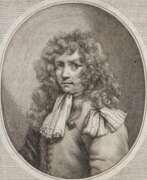

Thomas Blanchet, a distinguished French painter, sculptor, and architect, left an indelible mark on the Baroque era with his multifaceted talent. Blanchet's journey in art saw him transitioning from sculpture to painting under the guidance of Jacques Sarazin. His early years in Paris were enriched by the emerging Baroque influence and the Mannerism of the School of Fontainebleau, placing him among contemporaries like Simon Vouet.
Blanchet's formative years extended beyond French borders, as he ventured to Rome around 1645 to 1653. There, he immersed himself in the circle of Nicolas Poussin and visited the studios of Andrea Sacchi and Pietro da Cortona, earning high praise from Gianlorenzo Bernini. This period was marked by significant commissions, including works for Niccolò Guido di Bagno and the creation of engravings and mausoleums, notably in Venice for René de Voyer d'Argenson.
His repertoire was vast, encompassing classical themes, religious narratives, and architectural capriccios, as evidenced in works like "Time and Truth overcoming Envy and Discord" and "La Résurrection De Lazare". Blanchet's influence extended to Lyon, where he contributed to the city's cultural heritage through frescoes at the Collège de la Trinité, now Collège Ampère, and designed significant public and private spaces including the Palais de Roanne's grand chamber ceilings.
For collectors and experts in art and antiques, Thomas Blanchet's oeuvre represents a bridge between French and Italian Baroque, embodying the era's dramatic expressions and classical reverence. His works, found in both public spaces and museums, continue to be celebrated for their historical and artistic significance.
To stay informed about exhibitions, sales, and auctions related to Thomas Blanchet's works, signing up for our newsletter is recommended. This subscription ensures access to the latest insights and opportunities related to this Baroque master's enduring legacy.


Abraham Bloemaert was a Dutch painter, draughtsman, and printmaker from the Golden Age of Dutch painting, one of the founders of the Guild of St. Luke in Utrecht. Bloemart was a caravagist. He painted mainly landscapes, mythological and biblical scenes, and pastoral works.


Cornelis Bloemaert the Younger, a Dutch Golden Age painter and engraver, was born in Utrecht. He studied painting with his father and other prominent artists before focusing primarily on printmaking. Bloemaert traveled to Paris and Rome, where he made engravings of renowned Italian paintings. His engravings were known for their rich colors and smooth transitions. He collaborated with Charles de la Haye on the engraving of Pietro da Cortona's frescoes in the Palazzo Pitti. Bloemaert remained in Rome until his death, having achieved great success in his career. He was a member of the Bentvueghels art group.








